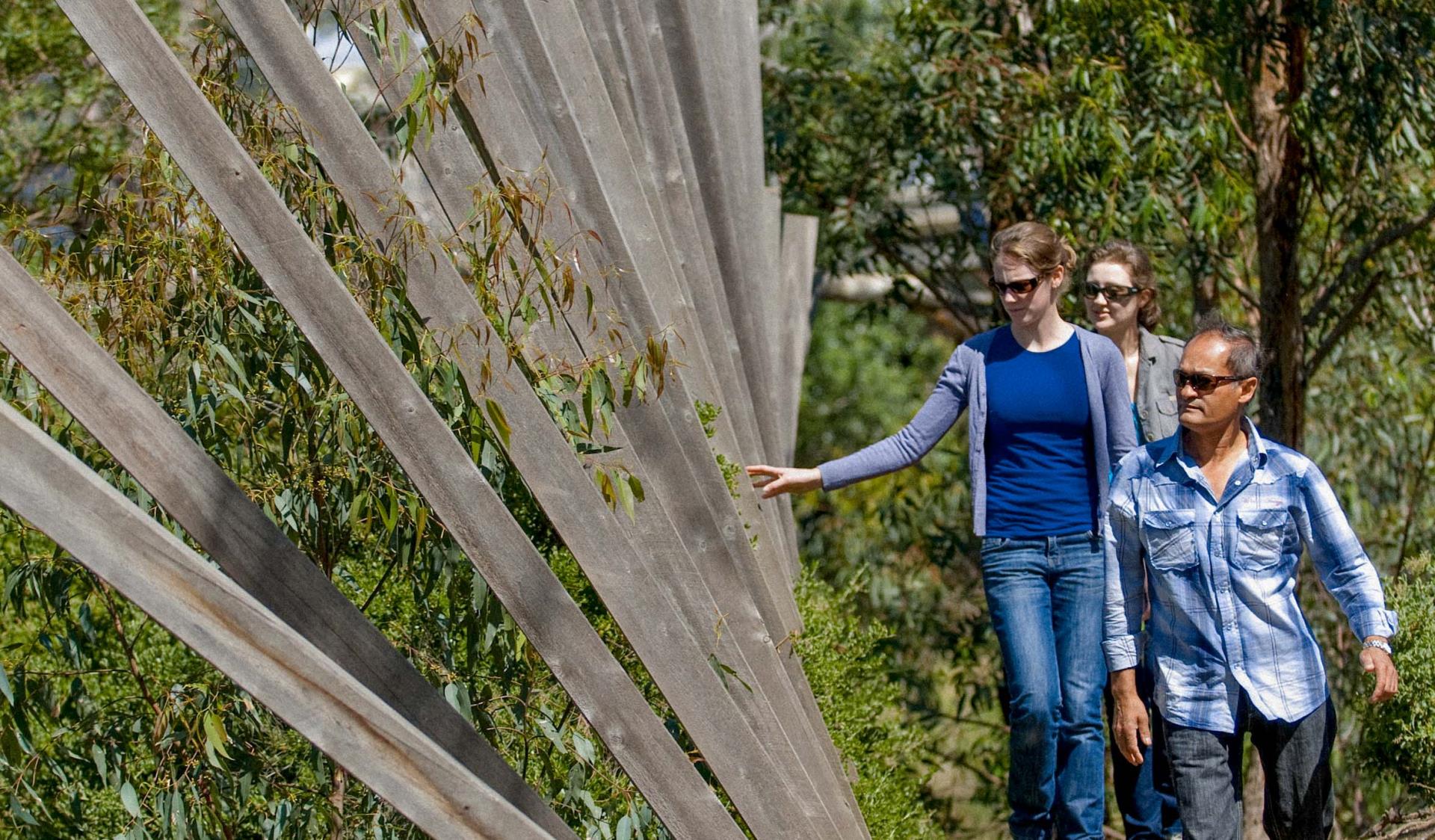Herring Island Sculpture Trail
Herring Island is home to nine environmental sculptures, interwoven into the parks’ landscape created by internationally renowned artists. These sculptures celebrate the natural environment. They were created using only natural materials and have since become an integral part of the island's landscape.
Download the Herring Island Visitor Guide for more information and a map of the island.
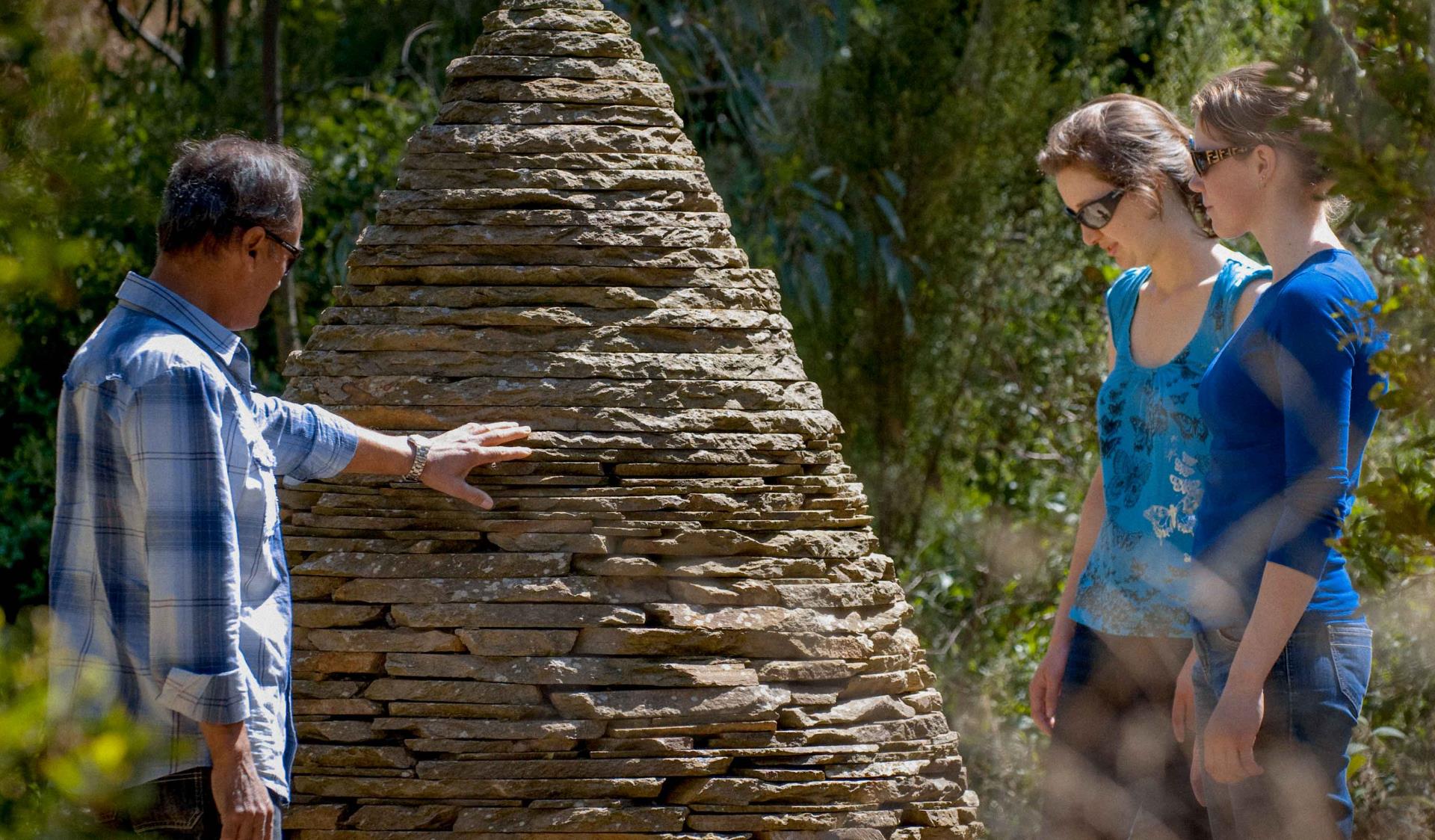
“The magic associated with the island, accessible only by vessel, its mystery and the sense of discovery one experiences after journeying over water has made this a perfect place for environmental sculptures harmonious with nature. Small and man-made, this island has provided an opportunity to build a sculpture park different from any other in Australia.
Like all islands Herring Island features, in miniature scale, headlands, valleys, mounds, cleared and overgrown, which provided the potential for artists to have discrete precincts for largescale site specific installations. The brief also included a necessity for the works to be built only in natural materials. In particular and appropriately, stone from various locations has been brought to the site of this former quarry which produced bluestone from which Melbourne's roads were built in the 19th Century. At that time, as the city was established, it was beautified by the creation of parklands, where, in some instances, gracious marble and bronze monuments were installed by civic authorities. This European tradition of placing beautiful artworks into recreational spaces has been adapted to meet the public's contemporary needs. At the end of the 20th Century, it is more appropriate to develop sculptures which emphasise the natural the stimulus of the city and its borders. Sharing a similar sensibility and a closeness with nature, artists have been selected who have focused upon the history and the landscape of this island. Their works, together with the wild topography, native planting and the renovated Scout Hall, which is now a gallery, have become part of the island's enigmatic ambience and unified, harmonious aesthetic."
- Maudie Palmer, curator
1. Audience (1997)
Burnley bluestone
Julie Collins
Created exclusively from bluestone taken from the tunnel under the Birrarung "Yarra River", Melbourne sculptor Julie Collins' work is intended to welcome visitors upon arrival to the island. Ambiguous carvings of strange creatures, at times reminiscent of native animals and birds, present a silent audience for visitors, whom the artist believes become performers when they enter the arena.
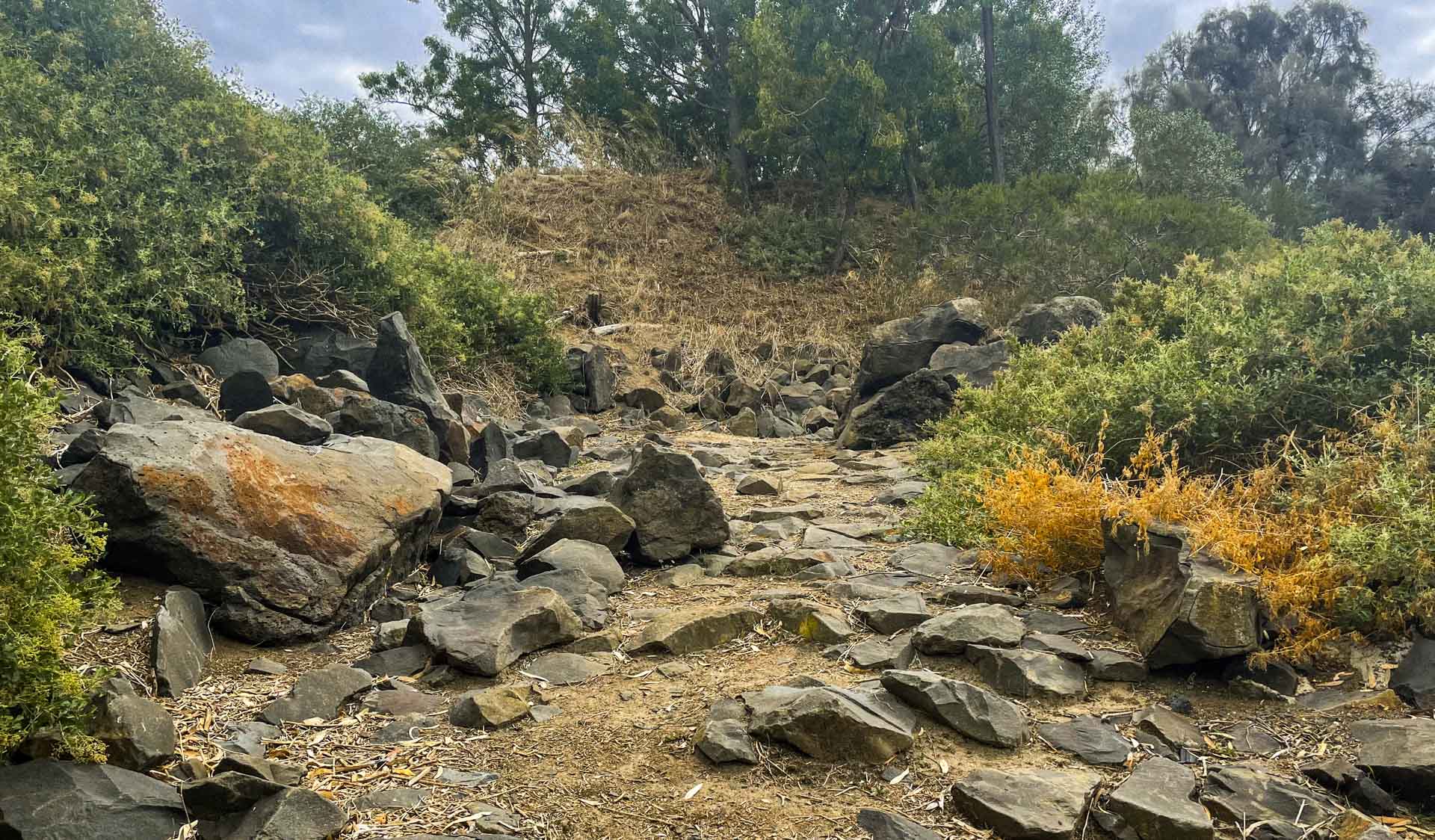
Artist statement from Julie Collins:
It was important for me to make an arrival piece. From Alexandra Avenue on the other side of the river, Audience looks like a strange pile of rocks. But the form is interesting from that viewpoint, enough to make people curious and want to come to the island.
I was very conscious about bringing materials to the island. I knew I wanted to work in bluestone, because the site used to be a part of a bluestone quarry. It was like giving something back to the island. And it was an amazing coincidence that the blasting of the tunnel under the Yarra at Burnley was happening at this time, so it was possible to get exactly the same stone from the same area. This is not obvious to the viewer, but to me, it is the most perfect solution for making work on Herring Island.
Even though Herring Island is man-made, my site appeared as a found amphitheatre in itself. It was the site that inspired the forms that I put there. It was the actual shape, the formation of the land that inspired what I was going to make.
The circular notion has been an ongoing theme in my work because the form brings people in, and I like the idea of people being able to come in and be a part of the sculpture. My carvings are not obvious. I respond to the form of the stone. I select stones that allude to certain forms, ambiguous creatures, birds perhaps. I then cut lines into the stone to bring out these forms. I see my sculpture and nature as being very close, so, for me if people look at a piece of sculpture which is a pile of rocks with a few subtle lines reminiscent of something which they may or may not recognise, then, for that brief moment, they will see beyond what they normally see. Children do it so well. My role as an artist is to help people remember the way they saw things as children.
2. A Hill, a River, Two rocks and a Presence (1997)
Earth, wood, limestone, sandstone, mixed media
John Davis
Designed and constructed by Melbourne sculptor John Davis, this sculpture represents elements of the past and the spirit of the land. The artist has combined the elements of water, timber, vegetation and limestone, which are found in the natural landscape and provide a sense of place and recognition of the island's source.
Artist statement from John Davis:
It took me quite a while to make up my mind what I wanted to do in this particular location. Eventually decided on a simple statement about the hill, the river and the rocks. The idea of the presence came later. I wanted a sense of a spirit hovering in the background. That presence could be prior inhabitants of the area, Aboriginal people, other historical figures that have been connected to the place, or quite simply some kind of spirit that's connected to the land.
I have a strong sense of the importance of the past and I wanted to reintroduce an element of the past. That past was a tree that has been cut down which I've rebuilt in a sense. It became more than that, it became a kind of a presence. It comes out of a stump, signifying the tree, and goes beyond that into more imaginative or subliminal areas.
I try to work within a sense of the place, its ambience, its scale. It may be a place, a gathering, a sense of energies that operate around that area. It's usually an open space surrounded by trees which probably goes back to when I was a kid. Living in the bush, that was the sort of place one would camp. When you put up a tent at night on the river and lit a fire, you always looked for not just anywhere, you tried to find a place that was special.
I like my work to be subtle so that you discover elements as you move between them: you look down at the ground as well as looking up. As part of the experience you have to use your body: you walk, kneel and bend. It's to do with all the things that are not there, as much as the things that are. And the things that are there work on what is not there.
The land is precious. Aboriginal people ask us to ‘tread lightly on the land.’ That's what I've tried to do in my piece. You don't stomp around it, you don't bruise it, you gently move through it. I think 'treading lightly' is a good phrase and I rather wish we could get more of that thinking occurring in Australia again. What I'm trying to do through my piece is say 'tread lightly' for a while. Be a little more caring and sensitive about what we do in certain places.
What I'd like to be maintained on Herring Island is that sense of isolation. I believe it should be a place of reflection, separate from the busy roads and city so people can contemplate the objects that are placed there and just enjoy the sun and the river and being away from the city.
3. Cairn (1997)
Castlemaine slate
Andy Goldsworthy
Located in the only natural valley on the island, Cairn was designed and constructed by Andy Goldsworthy using Castlemaine slate. The sculpture was created as a monument to growth.
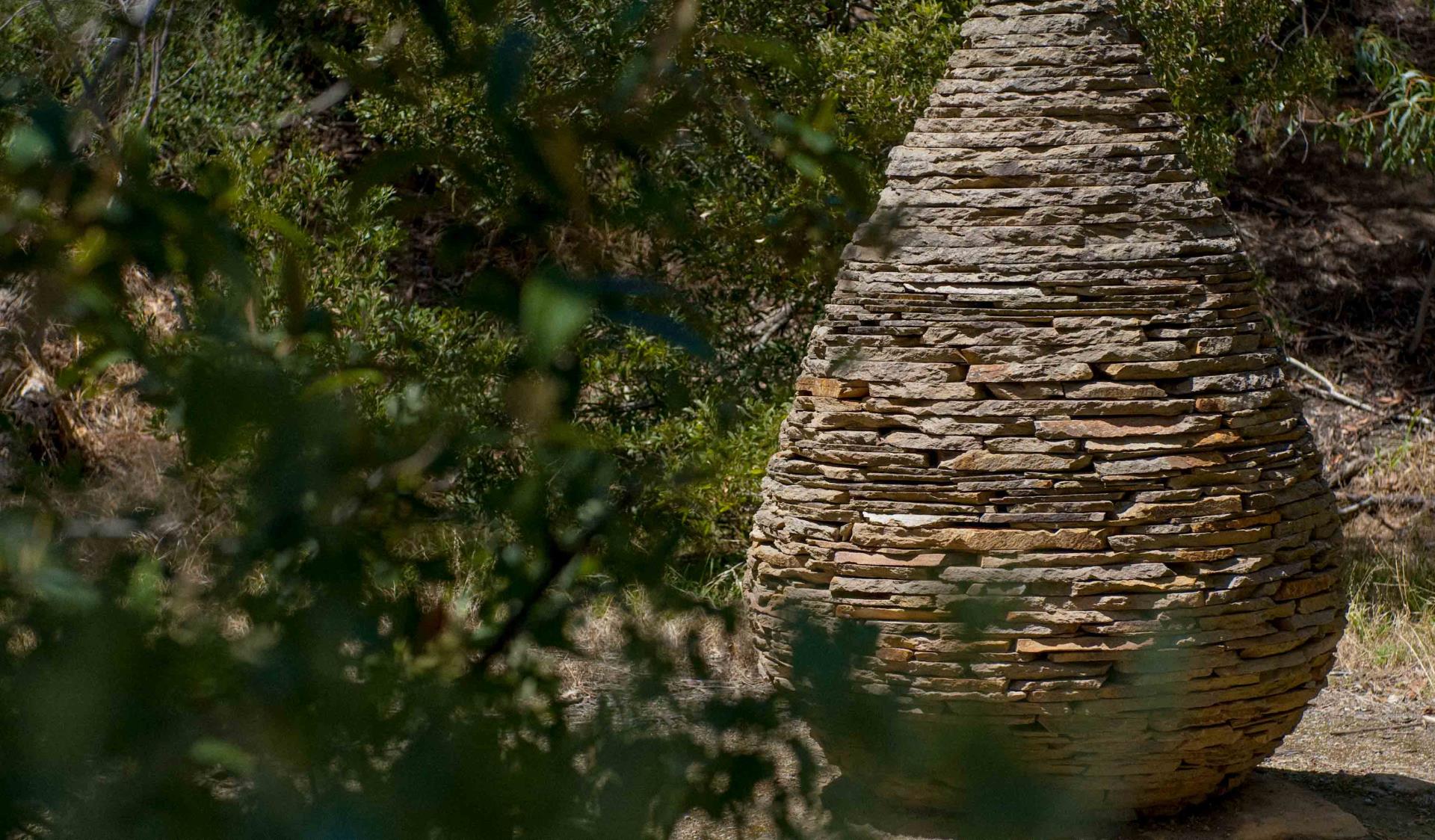
Artist statement from Andy Goldsworthy:
Before coming to Melbourne, I anticipated that I would make a cone. I asked for materials to be gathered that would be suitable for such a construction. The cone is a form that for me has its roots in the cairns and piles and stones that mark pathways in mountains in the North of England and Scotland. It has become for me a personal journey marker and in that sense is an appropriate form to work with when on a journey.
It is a work that can be seen both individually and in a context with those others that are made in different countries. When I arrived, the stone, although not perfect, was possible to be used to make a cone. At no point did I definitely say that the work would be a cone. I always wanted to leave the possibility open so that when I arrived I might respond and make a work for the place, which is how I would normally work. However, when I make these works, they are often preceded by many site visits beforehand and many times I've gone and made a feeler work first to get to know the place.
The cone is very much a rooting piece. Making it is a crash course in getting to know the place. There is a difference between taking something and making it in a place. Although the idea is the form which is in my mind as I arrive, in the making, it does become part of the place because it never is quite the same as the idea I brought there. In the process of making this cone, it grew tall and elegant and long, possibly because it is constructed in the dip, possibly because of the eucalypt leaves used to make the shape of a cone in the print that I made beforehand. So there are very marked differences in this cone from any other cone I've made because of its site, yet you wouldn't be aware that the form is different from the other works and it's that which interests me. I think ultimately it is best if the form, materials and everything comes from the site. This is a bit hard to anticipate when you are coming from another country.
I was very pleased how the cone held its own in a hollow where the viewer can look down upon it. I've always liked to see the belly, the base of it, but in fact, in this site, it not only held its own but became even stronger. I've always shown an image in my talk about the nine 'standers' that occupy the top of a hill possibly in the Oregan. They sit on the top of the hill and they're visible for miles around and they're really shouting for attention. My cones have been the antithesis of that. They're quiet, gentle monuments to growth, to the land.
4. Stone House (1997)
Dunkeld sandstone
Andy Goldsworthy
Made from Dunkeld sandstone, Andy Goldsworthy sculpture Stone House was created akin to the artist’s renowned ephemeral works, from his response to the site and objects found there. The artist envisioned this work to be observed from a distance, highlighting the sense of discovery and concealment of the island.
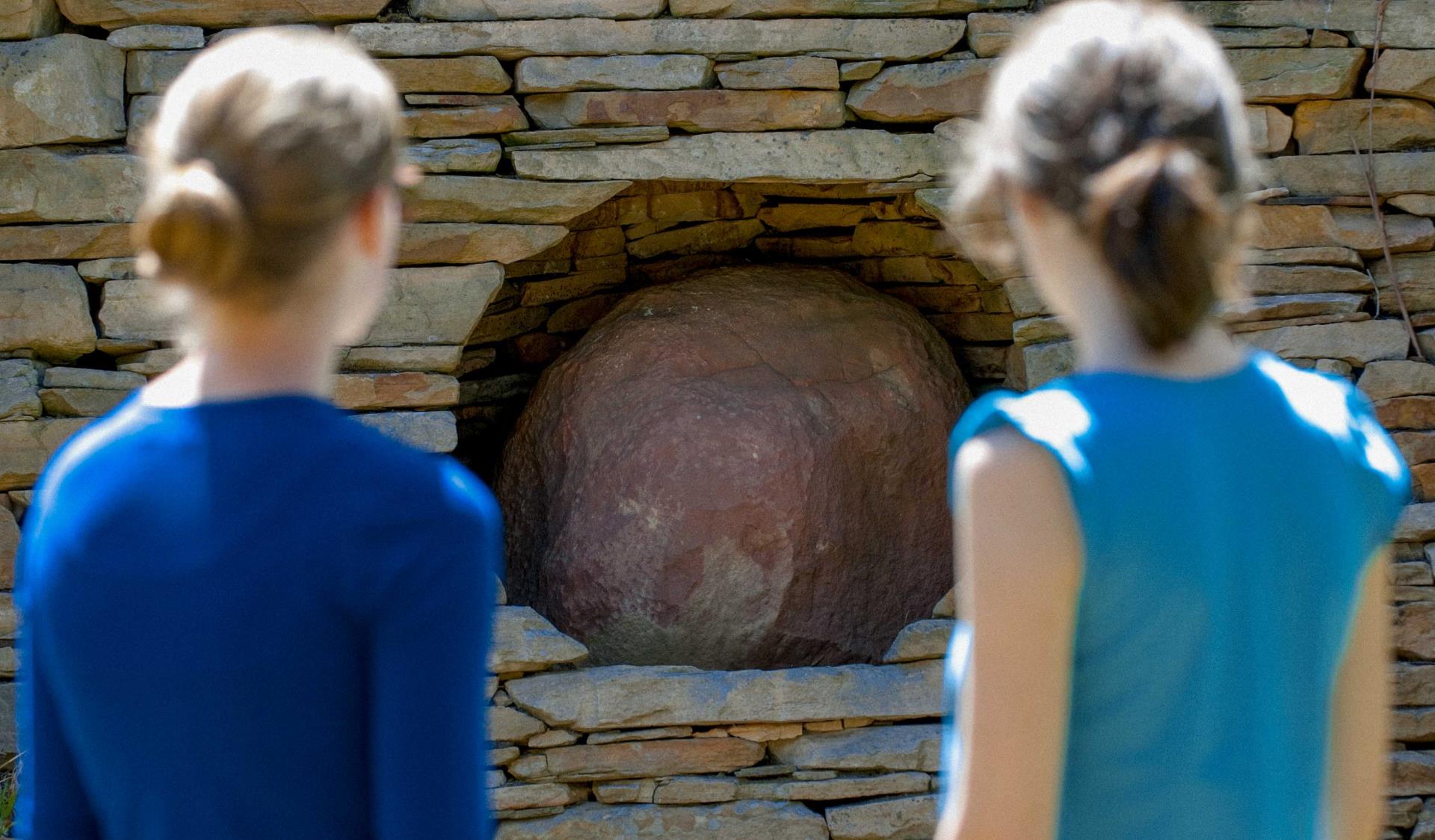
Artist statement from Andy Goldsworthy:
Amongst the large pile of stone there was a big red stone which interested me. The day after my arrival, we went up to the Grampians to see where the stone had come from and to select some more. I began work the following day and worked for one and a half days building the cone. About a third of the way up, I realised that the stone was not able to take the weight of the form and was cracking and opening. I abandoned that piece and decided to make a work with this sandstone around the red stone. When I went to the quarry, the quarry owner said to me ‘I hope you make something special with the red stone' and I quite liked that challenge. To make a work that somehow speaks of some of the qualities that I felt this red stone had. In effect I was making a house for this stone, a resting place for it.
Meanwhile, I managed to get some Castlemaine slate to remake the cone, so I had two works going on at the same time which was very interesting for me. One predicted and anticipated, the other not. The red stone in the wall is much closer to the way I usually make the ephemeral works. Trying to understand the space around the stone: that it has come up out of a quarry and its previous house was one in which it was embedded within and amongst other stone. It is very different from the cone. The wall is in itself embedded into the bank. It is rooted into the place. With this work I am much more concerned about the way it is seen and the surroundings. The cone to some extent is independent, aloof from its surroundings. The stone is much more reliant upon it and I have marked out a small path that leads you to the work. It is very important that this is how people approach Stone House, from a distance. It is a work that becomes stronger the further away you get from it. It has, for me, a very powerful presence. I hope that more bushes and trees will be planted around the work, thus giving the site a more isolated, intimate feel. The rock within the hole is like an island within the water. An island within an island. I've enjoyed working in the dip, the lowest part of the island which is itself a kind of hole. I think it is in the nature of an island to have a sense of discovery and concealment and I want to emphasise these qualities with this work. If people come here and do not find this piece and, when they talk of Herring Island afterwards, people ask them whether they saw it and they say no, then I think it has been successful. Not all is open and up front. There are things that can be missed if you don't look carefully for them, which possibly will provoke a return visit.
The making of a wall, the laying of stone piece by piece, leaves part of my energy within the work. I will always feel as if I am somehow in this place because of these pieces. In the same way when l am away from home, I think of the works around my home. There is a dialogue that I enjoy between these pieces and what are my concerns prior to coming here. My sculptural concerns.
The concept for Stone House has come from the holes and cairns in some ways. Strangely enough, I've been doing this work for the geological reserve in Digne in France, and I've been looking at the possibilities of housing, but, no, this is a new piece.
Stone House is somewhere between a permanent and ephemeral work. When I began making it I didn't know how I would resolve the area around the stone. In some ways there is a rawness and roughness - about the work. The sculpture doesn't stop at the stone, it is reliant upon the place. Its concealment and the dedicated line of approach is as much about the work as the work itself. I like being gently drawn into the place.
5. Steerage (1997)
Harcourt granite
Jill Peck
Canberra sculptor Jill Peck has created a large-scale Harcourt granite boat form at the westernmost point of the island as a metaphor for journeys, water and knowledge. A path leads up a bank between two mounds to reveal this unexpected resting place for contemplation. The prow of the sculpture and the Island point downstream towards the city's horizon.
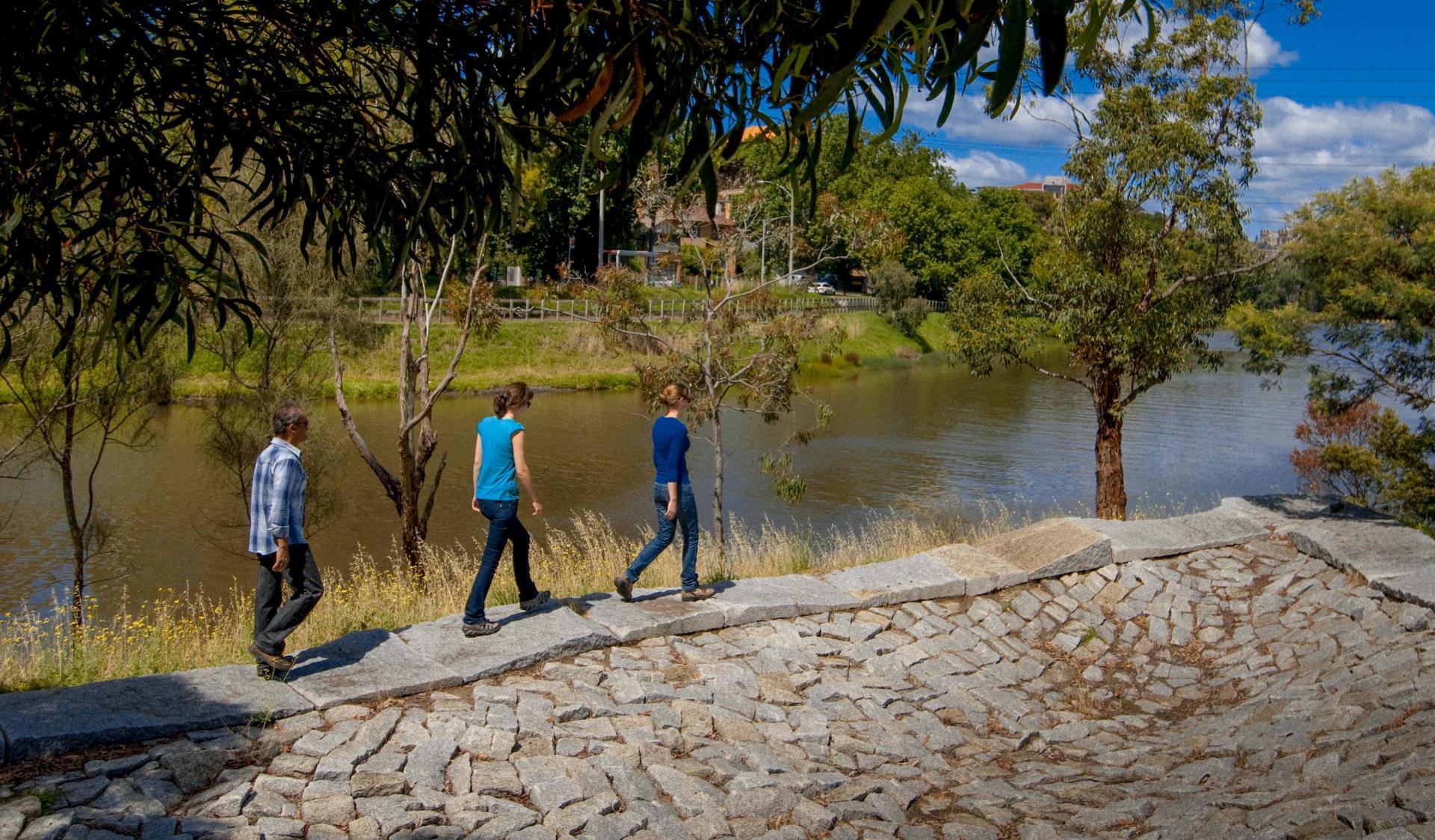
Artist statement from Jill Peck:
There are certain rhythms within the work that refer to nature and a sense of otherness: contemplation and tranquillity.
Part of the strength of the site is the perspective up the river towards the city which was continually being reinforced as the work was being made. Steerage was loosely based on the idea of a boat, because the idea of journeys and water interests me. In the seven weeks I was there, I was impressed by how much the Yarra River was used. The metaphor for journeys, water and knowledge comes from my interest in gaining an understanding of global environmental issues and the enrichment that is possible through the discoveries of environmental science.
Working on the point of the island gave me a special sense of being able to concentrate on my thoughts, because in effect while there was a lot going on around me, the island was suspended from the intensity of the city. I was not far away from anything, but in another sense I was miles away and able to go down quite deep into what's important.
The changes between my first visit and when I came to install the work were dramatic. The site had been flattened. I witnessed the shock of intervention.
I almost had to align myself with the workers' original activity of taking away the stone and then later bringing silt to the island. Just as the quarry men would have excavated, I had to find a way to forge forward in an imaginative and poetic sense and to superimpose another reality onto this flattened site. So, the focus for me was movement and that was central to the development of the idea of the work.
I thought about the structural engineer's advice about the site and the silt and how the work couldn't possibly be sustained in a vertical position. I had imagined a kind of silt base like a sand dune, but when we began to excavate, we discovered evidence of a previous history of concrete footings, cabled with wire and all kinds of small stones. Then, towards the back of the shape, there was the other reality which the report was based upon: this shifting, sandy, silty, unstable condition which provided another layer in understanding the man-made nature of the island.
I'm fascinated by the discovery of the moving elements of tectonic plates and how the major catastrophes in the world are often catalysts coming from the sea, they're often things that are happening in the ocean and they affect the land. I'm very interested in this duality. When we're talking about water and knowledge we're also talking about its effect on land. My work on Herring Island is almost like a tension between these issues: what is the sea is also the land. The idea of a man-made boat which is stone and which has nothing to do with floating and is to do with mining and going down into a subterranean level of knowledge.
I'm interested in the Aboriginal belief that the sea supports subsequent generations and that there is no difference between land and sea, as opposed to our Western historical view of not only the high adventures of the sea but the exotic nature of journeys and travel; the sea as resource, offering a separate set of criteria which is opposed to the Aboriginal notions of continuity.
6. Tanderrum ‘Coming Together’ (1997)
Mount William greenstone, Castlemaine slate, Red Box, native plants
Ellen José
Aboriginal culture emphasises the land, water, and sky as central to the spirit of the Australian landscape and part of the living spiritual domain. Together Aboriginal and Torres Strait islander artist Ellen José and Joy Murphy, Wurundjeri Tribal Elder, have imagined a vision for the creation of flight. Tanderrum 'Coming Together' brings together concepts of pride, culture, and spirit, and symbolises the coming together of the Kulin nation as one people. Constructed of Mt. William greenstone, Castlemaine slate, and Redbox (the wood). The greenstone was used for axe-heads by Aboriginal people prior to the arrival of Europeans in Australia. The axe-heads were traded between Aboriginal groups in South East Australia. The sculpture was renovated in January 2008.
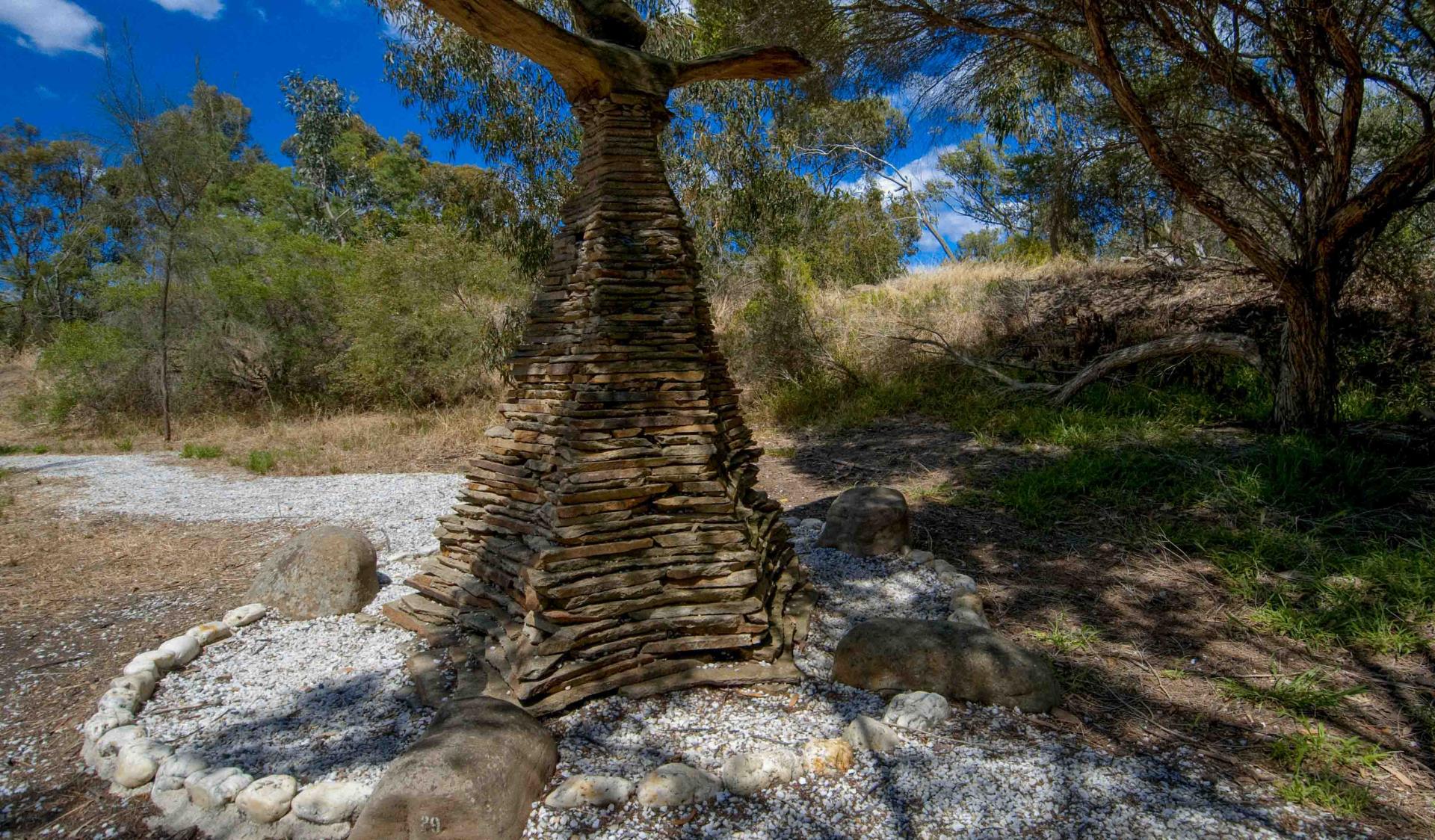
Artist statement from Ellen José:
With advice from local Aboriginal elders, Ellen José has established an Aboriginal installation as a meeting and contemplation space, defined by native planting, pebbles and rockş: Five symbolic markers honour the main tribal clans of Melbourne's metropolitan area - Bunnerong, Woiwurrong, Taungerong, Wathaurong and Kurong. The sculptural installation, Tanderrum, links the symbols and legends of the Dreaming with ancestral bird spirits and totems of the five clan groups inherent to the symbolic representation of flight.
Imagining a vision for the creation of flight, Torres Strait Islander Ellen José, artist, and Joy Murphy, Wurundjeri Tribal Elder have come together as one. In representing the Wurundjeri Tribe, Joy provides a contextual backdrop as follows:
The Wurundjeri Tribe is part of the Kulin nation. Kulin means man. In the Kulin nation there were five clans, five language groups:
- the Wathaurong to the West
- the Kurong, who are the westerly neighbours to the Wathaurong
- the Taungerong to the North East
- the Bunnerong to the South East
- the Woiwurrong of the Wurundjeri territory
The Wurundjeri territory lies within the inner city of Melbourne and extends from the mountains of the Great Dividing Range to the Yarra River and the Dandenongs, west to the Werribee River and east to Mt Baw Baw.
Tanderrum 'Coming Together', brings together concepts of pride, culture and spirit and the work symbolises the coming together of the Kulin nation of people as one people.
Mount William greenstone was incorporated because it was used as a trading stone, like money, many years ago. Mount William is only an hour's drive from Melbourne, yet the stone has been found as far afield as the Kimberleys.
Each clan has different totems – the eagle, the sea bird, the bat, the bogong moth, the white butterfly and the black raven. I chose plants that are good, not for just bush tucker, but medicine as well. There's a plant (Arthropodium strictum) that smells a bit like chocolate when the flowers are out. The people used to dig them out of the ground and crush them up and put them in a still part of the water. The next thing all the fish and eels would float to the top. It was an easy way of fishing.
In the long term the work will be covered by a canopy of foliage, an enclosure. People won't actually see it until they walk into the canopy. It will become a secret place. A place of shadows and filtering light.
7. Ramp (1998)
Red Gum
Robert Jacks
Designed and constructed by Victorian Sculptor Robert Jacks, from the remains of a 250-year-old Red Gum tree. Ramp responds and relates to the tranquil environment of the island and the demanding urban dimension of the freeway across the river.
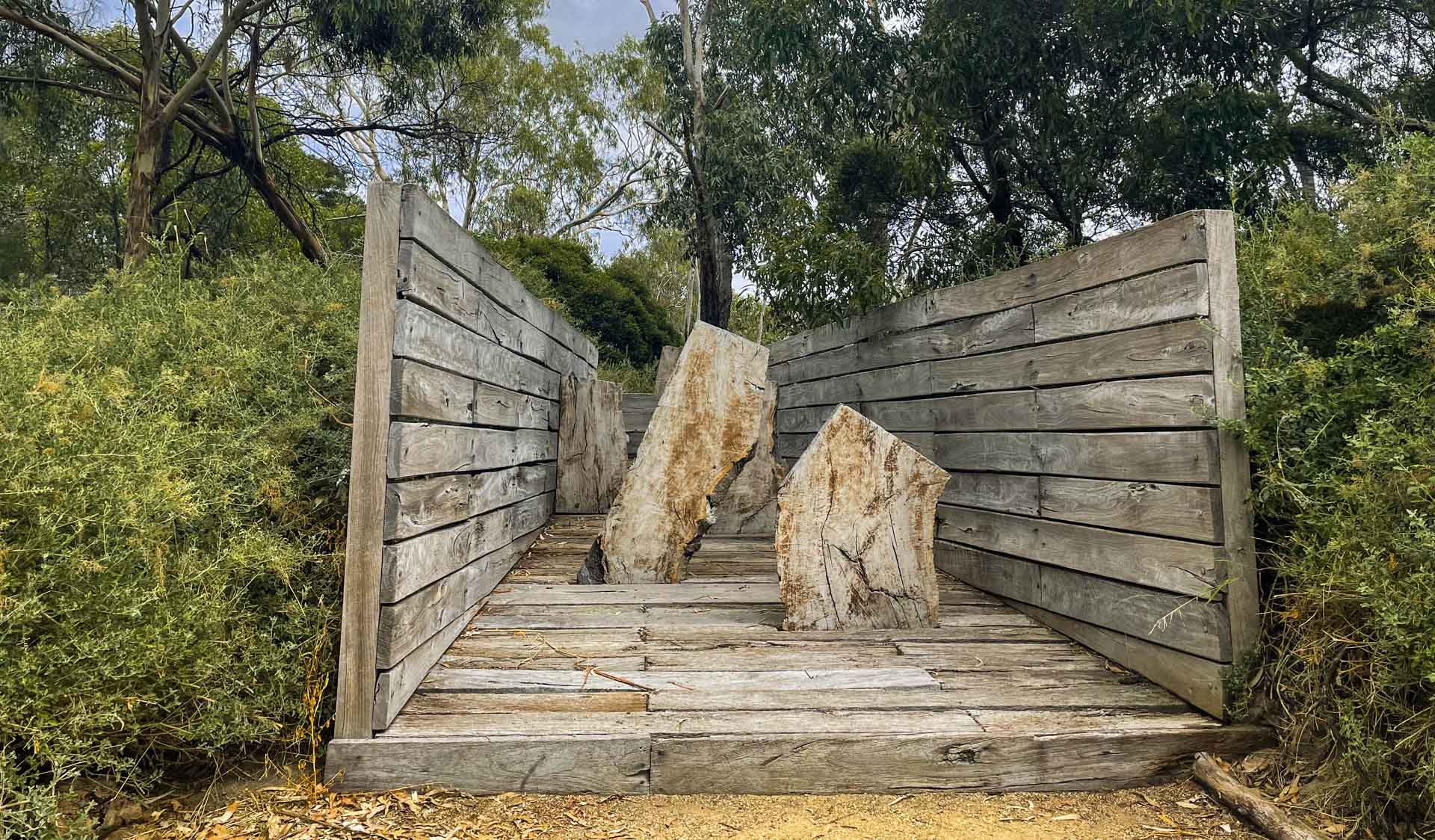
Artist Statement from Robert Jacks:
Since my early childhood Herring Island has been a significant place for me. When I was six years of age my family moved from South Yarra to an old rambling house on the Yarra at Burnley. A favourite pastime for my friends and I was to build small raft boats from wood and tin in which we sailed up and down the river aided by the tide (which reaches that far from Port Phillip Bay), playing “pirates'. The scary, uninhabited, fascinating island was part of this adventure.
My father studied at the Horticultural College in Burnley and then became the Curator of Parks and Gardens for Richmond. During that time he wrote a report which recorded the high salinity levels on Herring Island. Now, after the rains over the years have diminished the level of salt in the soil, it is a joy to see many native plants thriving.
Choosing such a difficult site created a major challenge for me to make a work. I have wedged the sculpture into a cutting to make a connection between the tranquillity of the island within the levee banks and the hideous roar of the traffic on the freeway across the river.
When choosing the materials I went through a process of elimination. It would have been obvious for me to use Harcourt granite because my house and studio have been built from this stone. One could say the granite came from my backyard. Instead, I chose red gum timber as this was also available from my immediate environment and would survive well on the high and dry site I had chosen. The basic structure of walls and floor was made with timber from the Murray River area, while the shapes that protrude from the floor of this structure were cut from a very old dead tree which had fallen down so long ago that none of the 'locals' could remember when. Cutting these slabs was a very slow process. They are over 250 years old with the most beautiful grain that shows their long and hard life.
I feel that this is the most 'Australian' sculpture I have ever made, that it has direct contact with the land. For generations landscape has been the dominant subject matter of Australian painting, continually revitalising it. Generally, landscape is too difficult a subject for Australian sculpture. I want people to become part of the sculpture to explore its cluster of shapes echoing the past, long before we were in this land. I want people to walk onto it and touch it, so it will become worn and with time be reminiscent of an old cattle ramp or other rural architectural remnants, changing colour with time and the weather.
8. Scaled Stem (1999)
Monterey Cypress
Robert Bridgewater
Designed and created by Melbourne sculptor Robert Bridgewater, a sinuous form detailed with intricate patterning carved in Monterey Cypress, Scaled Stem can be linked with a budding plant, a club, a fishing float, kitchen utensil or scientific apparatus. Bridgewater states that the work "is part of a continuing line of enquiry concerned largely with relationships between form, pattern, craft and material and the poetic associations that can be evoked via these relationships". The organic worked textures of Scaled Stem highlight "an inseparability and interdependence between notions of nature and culture".
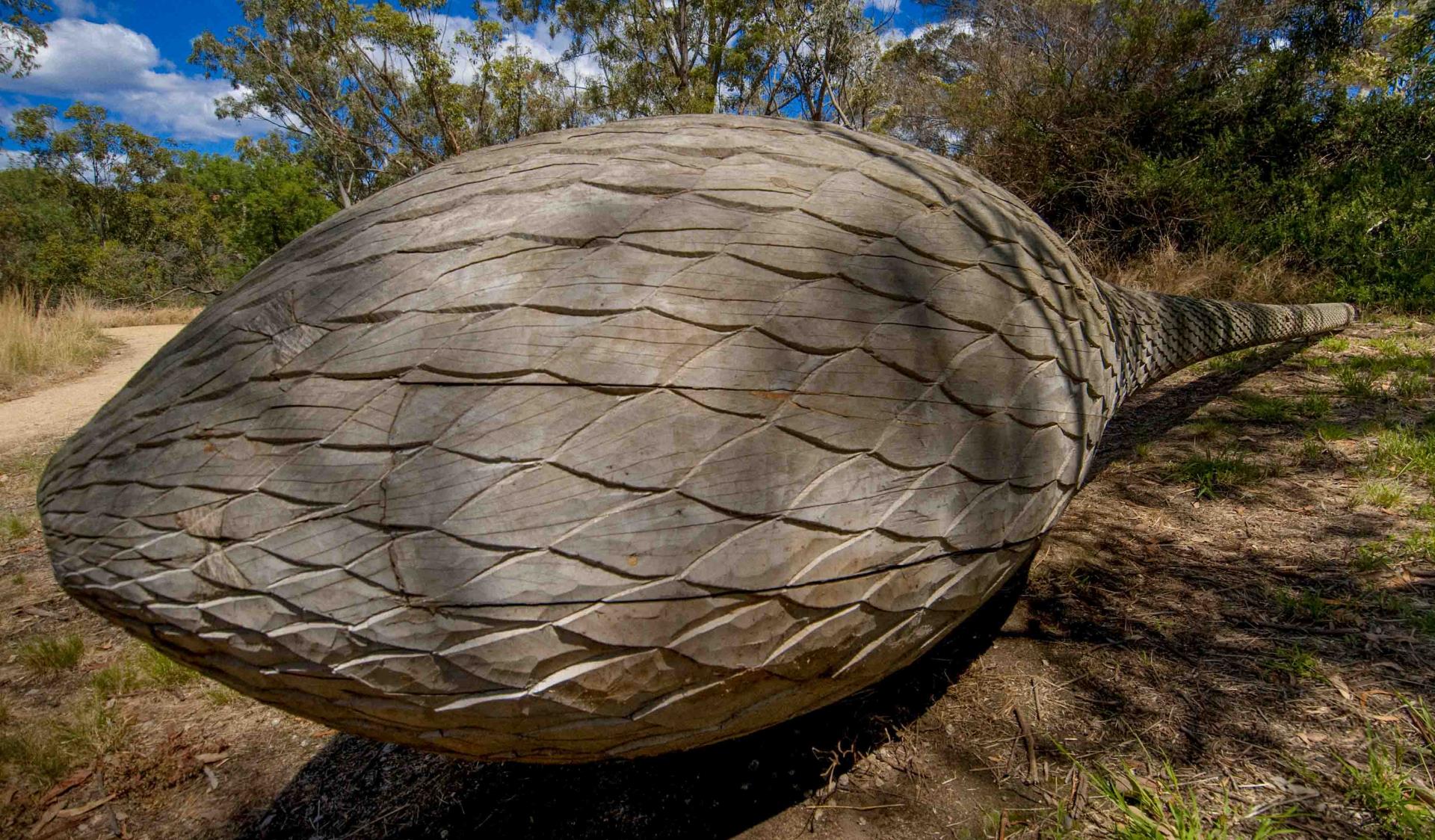
9. Falling Fence (2001)
John Gollings and Samantha Slicer
Extending the traditions formed in the 1970s of earthworks and environmental art, Falling Fence is the first major sculptural work by internationally acclaimed Melbourne based photographer John Gollings and his assistant Samantha Slicer. The work has been designed specifically for its site on the Northern bank of the island with the artists intention for the sculpture to mellow with time, to merge and eventually to be absorbed into the landscape.
